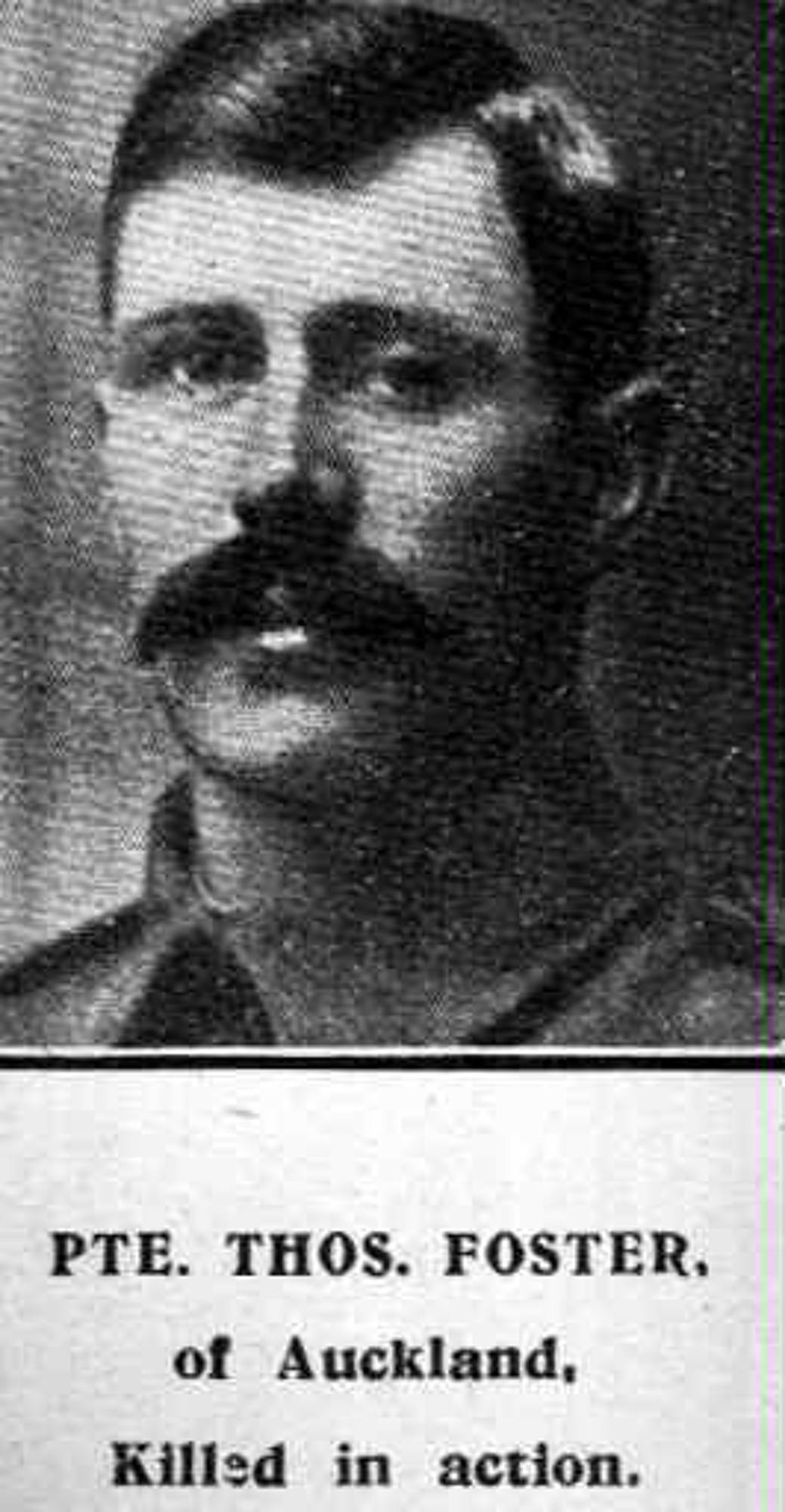Pte
Thomas George Foster
Informatie over geboorte
|
Geboortedatum: 01/04/1887 |
|
Geboorteplaats: Coromandel, Waikato, Nieuw-Zeeland |
Algemene Informatie
|
Beroep: Bushman |
Informatie legerdienst
|
Land: Nieuw-Zeeland |
|
Strijdmacht: New Zealand Expeditionary Force |
|
Rang: Private |
|
Service nummer: 6/2414 |
|
Dienstneming datum: 02/03/1915 |
|
Dienstneming plaats: Trentham, Wellington, Nieuw-Zeeland |
|
Eenheden: — Canterbury Regiment, 2nd Bn. (Laatst gekende eenheid) |
Informatie over overlijden
|
Datum van overlijden: 19/02/1918 |
|
Plaats van overlijden: Judge Cross Roads, België |
|
Doodsoorzaak: Killed in action (K.I.A.) |
|
Leeftijd: 30 |
Begraafplaats
|
Polygon Wood Cemetery Plot: / Rij: G Graf: 15 |
Onderscheidingen en medailles 2
|
British War Medal Medaille |
|
Victory Medal Medaille |
Points of interest 3
| #1 | Geboorteplaats | ||
| #2 | Dienstneming plaats | ||
| #3 | Plaats van overlijden (bij benadering) |
Mijn verhaal
Private Thomas George Foster, a 30 year old bushman, served in the Canterbury Regiment 2st Battalion, part of the 2nd New Zealand Brigade, of the New Zealand Division.
The Division participate in the Battle of Passchendaele in 1917. After the offensive the New Zealand Division held the line in and around Polygon Wood. In early December the New Zealand Division wanted to improve its positions and tried to take the heights round Polderhoek Chateau. The Division made some gains, suffering heavy casualties, but they did not succeed in capturing the Chateau and the surrounding heights.
The new front line system had to be fortified, and the Battalions in the line worked on improving their trenches. Except in a few places close up the frontline, there were no communication trenches in the Divisional sector. All the traffic up to the line was confined to a few duck tracks. The Germans were well aware of these tracks, which were frequently shelled. From their positions in Polderhoek Chateau they had an excellent view on the British and New Zealand positions.
At first the muddy terrain round the tracks smothered many shells, greatly reducing the danger. But when it started freezing days before Christmas the terrain hardened. At first this seemed to make lives in the trenches a bit better as the ground became solid. However it did not much add to the discomfort, as the frozen ground increased the danger zone of the shells. Consequently even badly aimed shells could cause casualties to troops using the tracks.
Later on, when frosty nights were followed by sunny days, several casualties were caused by gas. The content of gas shells that were fired during the night, had remain liquid till the heat of the sun caused them to evaporate. In the morning of 18 February the headquarters of the 2nd Brigade and 2nd Canterbury Battalion were gassed at the Butte.
By the end of February the New Zealand Division had been in the line for over three months. The 2nd Canterbury Battalion was in the line at Judge Cross roads, when they were relieved in the night of 22/23 February. Private Thomas George Foster was killed in the Judge Cross Roads sector. He possibly fell due to shell fire while holding and improving the frontline. He was buried at Polygon Wood cemetery, where he is still remembered today.
The Division participate in the Battle of Passchendaele in 1917. After the offensive the New Zealand Division held the line in and around Polygon Wood. In early December the New Zealand Division wanted to improve its positions and tried to take the heights round Polderhoek Chateau. The Division made some gains, suffering heavy casualties, but they did not succeed in capturing the Chateau and the surrounding heights.
The new front line system had to be fortified, and the Battalions in the line worked on improving their trenches. Except in a few places close up the frontline, there were no communication trenches in the Divisional sector. All the traffic up to the line was confined to a few duck tracks. The Germans were well aware of these tracks, which were frequently shelled. From their positions in Polderhoek Chateau they had an excellent view on the British and New Zealand positions.
At first the muddy terrain round the tracks smothered many shells, greatly reducing the danger. But when it started freezing days before Christmas the terrain hardened. At first this seemed to make lives in the trenches a bit better as the ground became solid. However it did not much add to the discomfort, as the frozen ground increased the danger zone of the shells. Consequently even badly aimed shells could cause casualties to troops using the tracks.
Later on, when frosty nights were followed by sunny days, several casualties were caused by gas. The content of gas shells that were fired during the night, had remain liquid till the heat of the sun caused them to evaporate. In the morning of 18 February the headquarters of the 2nd Brigade and 2nd Canterbury Battalion were gassed at the Butte.
By the end of February the New Zealand Division had been in the line for over three months. The 2nd Canterbury Battalion was in the line at Judge Cross roads, when they were relieved in the night of 22/23 February. Private Thomas George Foster was killed in the Judge Cross Roads sector. He possibly fell due to shell fire while holding and improving the frontline. He was buried at Polygon Wood cemetery, where he is still remembered today.
Bronnen 1
|
Ferguson D., The History of the Canterbury Regiment, N.Z.E.F. 1914-1919, (Auckland, Whitcombe and Tombs Limited, 1921), pg. 218-224. Gebruikte bronnen |
Meer informatie 5
|
Commonwealth War Graves Commission Database https://www.cwgc.org/find-records/find-war-dead/casualty-details/480026 |
|
Namenlijst (In Flanders Fields Museum) https://namenlijst.org/publicsearch/#/person/_id=cfde396b-3432-4e39-a1fb-ffb94e636e2b |
|
Lives of the First World War (Imperial War Museum) https://livesofthefirstworldwar.iwm.org.uk/lifestory/7174649 |
|
Online Cenotaph (Auckland Museum) https://www.aucklandmuseum.com/war-memorial/online-cenotaph/record/c5057 |
|
The NZEF Project (UNSW Canberra) https://nzef.adfa.edu.au/showPerson?pid=85030 |
